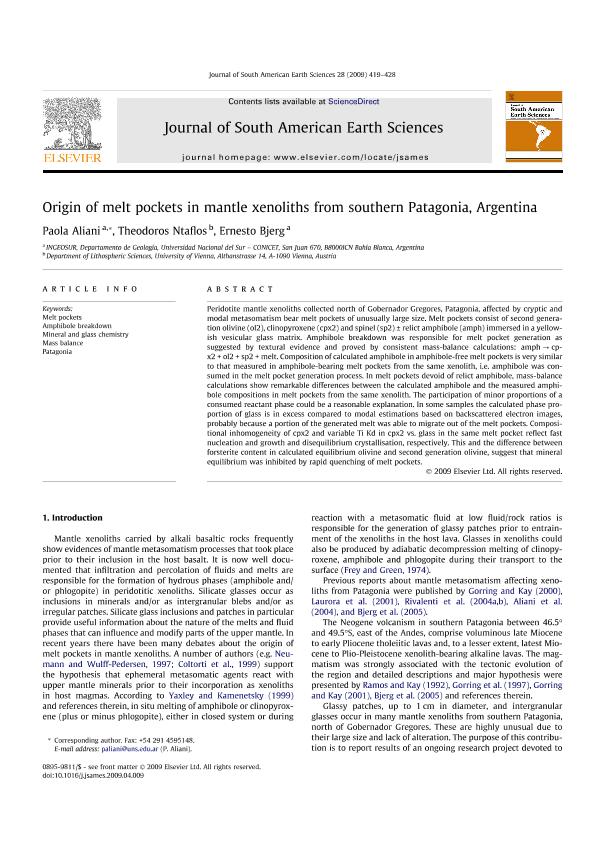Mostrar el registro sencillo del ítem
dc.contributor.author
Aliani, Paola

dc.contributor.author
Ntaflos, Theodoros
dc.contributor.author
Bjerg, Ernesto Alfredo

dc.date.available
2019-05-27T13:54:16Z
dc.date.issued
2009-12
dc.identifier.citation
Aliani, Paola; Ntaflos, Theodoros; Bjerg, Ernesto Alfredo; Origin of melt pockets in mantle xenoliths from southern Patagonia, Argentina; Pergamon-Elsevier Science Ltd; Journal of South American Earth Sciences; 28; 4; 12-2009; 419-428
dc.identifier.issn
0895-9811
dc.identifier.uri
http://hdl.handle.net/11336/77154
dc.description.abstract
Peridotite mantle xenoliths collected north of Gobernador Gregores, Patagonia, affected by cryptic and modal metasomatism bear melt pockets of unusually large size. Melt pockets consist of second generation olivine (ol2), clinopyroxene (cpx2) and spinel (sp2) ± relict amphibole (amph) immersed in a yellowish vesicular glass matrix. Amphibole breakdown was responsible for melt pocket generation as suggested by textural evidence and proved by consistent mass-balance calculations: amph → cpx2 + ol2 + sp2 + melt. Composition of calculated amphibole in amphibole-free melt pockets is very similar to that measured in amphibole-bearing melt pockets from the same xenolith, i.e. amphibole was consumed in the melt pocket generation process. In melt pockets devoid of relict amphibole, mass-balance calculations show remarkable differences between the calculated amphibole and the measured amphibole compositions in melt pockets from the same xenolith. The participation of minor proportions of a consumed reactant phase could be a reasonable explanation. In some samples the calculated phase proportion of glass is in excess compared to modal estimations based on backscattered electron images, probably because a portion of the generated melt was able to migrate out of the melt pockets. Compositional inhomogeneity of cpx2 and variable Ti Kd in cpx2 vs. glass in the same melt pocket reflect fast nucleation and growth and disequilibrium crystallisation, respectively. This and the difference between forsterite content in calculated equilibrium olivine and second generation olivine, suggest that mineral equilibrium was inhibited by rapid quenching of melt pockets.
dc.format
application/pdf
dc.language.iso
eng
dc.publisher
Pergamon-Elsevier Science Ltd

dc.rights
info:eu-repo/semantics/openAccess
dc.rights.uri
https://creativecommons.org/licenses/by-nc-sa/2.5/ar/
dc.subject
Amphibole Breakdown
dc.subject
Mass Balance
dc.subject
Melt Pockets
dc.subject
Mineral And Glass Chemistry
dc.subject
Patagonia
dc.subject.classification
Meteorología y Ciencias Atmosféricas

dc.subject.classification
Ciencias de la Tierra y relacionadas con el Medio Ambiente

dc.subject.classification
CIENCIAS NATURALES Y EXACTAS

dc.title
Origin of melt pockets in mantle xenoliths from southern Patagonia, Argentina
dc.type
info:eu-repo/semantics/article
dc.type
info:ar-repo/semantics/artículo
dc.type
info:eu-repo/semantics/publishedVersion
dc.date.updated
2019-04-23T14:40:15Z
dc.journal.volume
28
dc.journal.number
4
dc.journal.pagination
419-428
dc.journal.pais
Países Bajos

dc.journal.ciudad
Amsterdam
dc.description.fil
Fil: Aliani, Paola. Consejo Nacional de Investigaciones Científicas y Técnicas. Centro Científico Tecnológico Conicet - Bahía Blanca. Instituto Geológico del Sur. Universidad Nacional del Sur. Departamento de Geología. Instituto Geológico del Sur; Argentina
dc.description.fil
Fil: Ntaflos, Theodoros. Universidad de Viena; Austria
dc.description.fil
Fil: Bjerg, Ernesto Alfredo. Consejo Nacional de Investigaciones Científicas y Técnicas. Centro Científico Tecnológico Conicet - Bahía Blanca. Instituto Geológico del Sur. Universidad Nacional del Sur. Departamento de Geología. Instituto Geológico del Sur; Argentina
dc.journal.title
Journal of South American Earth Sciences

dc.relation.alternativeid
info:eu-repo/semantics/altIdentifier/doi/https://doi.org/10.1016/j.jsames.2009.04.009
dc.relation.alternativeid
info:eu-repo/semantics/altIdentifier/url/https://www.sciencedirect.com/science/article/pii/S0895981109000601
Archivos asociados
